Text
So, this is what I’ve been working on for a while- an education-themed blog! I will post every two days some info about a cool animal, as well as reblogs and random extra posts and all that. First I’m going to post about the primate family (+ close kin), with all the primates included in the tournament as well as an extra 35 or so I thought were also interesting. Next I’m planning to post about hoofed mammals, which are like primates in that people assume they’re just basic mammals, but there’s so much more to discover under the surface. I hope at least some of you join me on this journey, because there’s so many unbelievable species and stories that I can’t believe nobody is talking about already! And for the animals we’ve all heard of before, it often takes a second look to realise just how weird they actually are!
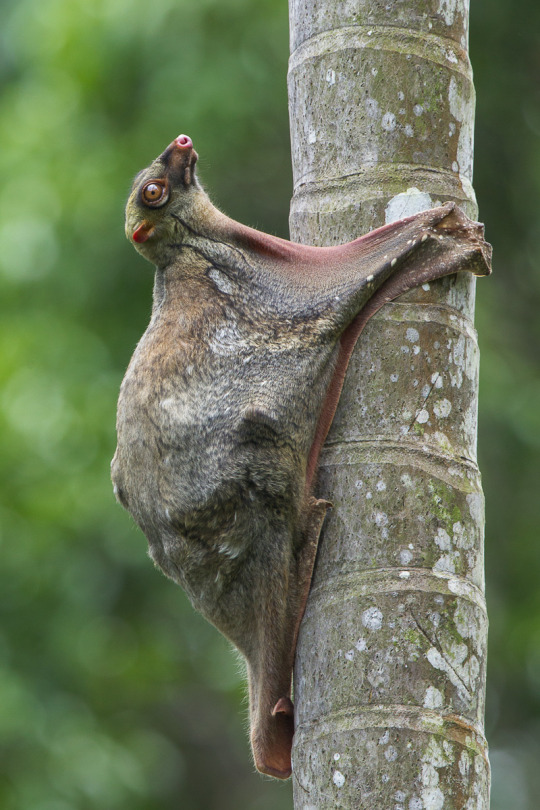
Sunda flying lemur (Galeopterus variegatus)
Not a lemur at all, this nocturnal glider is actually the closest living relative of primates. Also called the Sunda colugo, it is found in the tropical forests of Southeast Asia, including the Malaysian peninsula and the islands of Sumatra and Borneo. It eats leaves, flowers, fruit, and sap. Although it can’t technically fly, and its extensive skin membrane certainly looks awkward, it is one of the best gliders in the animal kingdom!
47 notes
·
View notes
Text
And the winner of the primate tournament is… the Bornean orangutan!

Huge thanks to everyone for participating and learning about all these wonderful critters!
#primate bracket#ultimate librarian sweep#Maurice sweep?#too many good orangutan characters#no wonder people like them
42 notes
·
View notes
Text
Last day to vote in the tournament!
Primate tournament: final round
Bearded emperor tamarin (Saguinus imperator subgrisescens)

This tiny, tiny tamarin is found in the wet forests where Brazil and Peru border each other. They eat fruit, flowers, fungus, and tree sap- but they’re apparently too lazy to dig their own holes in trees, so they wait for a different species to do it for them. And, of course, they have those magnificent moustaches.
Bornean orangutan (Pongo pygmaeus)
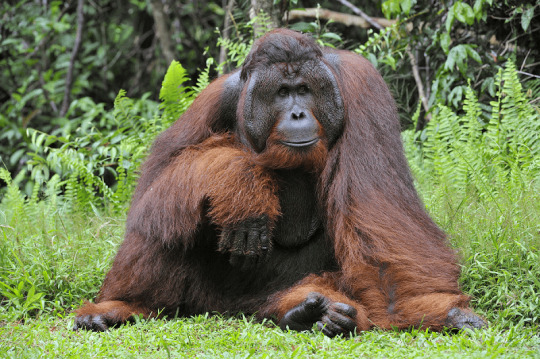
These large tree-dwelling apes are found only on the island of Borneo. They are highly sexually dimorphic, with older males growing large cheek flanges. They eat fruits, leaves, flowers, bark, honey, small animals like insects, spider webs, fungus, and soil. They build complex nests to sleep in, and have been observed using leafy makeshift ‘umbrellas’, sticks to obtain foods like ants, and leaves to hold spiny fruits.
71 notes
·
View notes
Text
Primate tournament: final round
Bearded emperor tamarin (Saguinus imperator subgrisescens)

This tiny, tiny tamarin is found in the wet forests where Brazil and Peru border each other. They eat fruit, flowers, fungus, and tree sap- but they’re apparently too lazy to dig their own holes in trees, so they wait for a different species to do it for them. And, of course, they have those magnificent moustaches.
Bornean orangutan (Pongo pygmaeus)

These large tree-dwelling apes are found only on the island of Borneo. They are highly sexually dimorphic, with older males growing large cheek flanges. They eat fruits, leaves, flowers, bark, honey, small animals like insects, spider webs, fungus, and soil. They build complex nests to sleep in, and have been observed using leafy makeshift ‘umbrellas’, sticks to obtain foods like ants, and leaves to hold spiny fruits.
71 notes
·
View notes
Text
Primate tournament: final round
Bearded emperor tamarin (Saguinus imperator subgrisescens)

This tiny, tiny tamarin is found in the wet forests where Brazil and Peru border each other. They eat fruit, flowers, fungus, and tree sap- but they’re apparently too lazy to dig their own holes in trees, so they wait for a different species to do it for them. And, of course, they have those magnificent moustaches.
Bornean orangutan (Pongo pygmaeus)

These large tree-dwelling apes are found only on the island of Borneo. They are highly sexually dimorphic, with older males growing large cheek flanges. They eat fruits, leaves, flowers, bark, honey, small animals like insects, spider webs, fungus, and soil. They build complex nests to sleep in, and have been observed using leafy makeshift ‘umbrellas’, sticks to obtain foods like ants, and leaves to hold spiny fruits.
71 notes
·
View notes
Text
Semifinals rematch round!
Verreaux’s sifaka (Propithecus verreauxi)

These lemurs are very specialised for living in trees, eating mostly leaves and being capable of leaping ten metres from tree to tree. They also live in a variety of wet or dry forest habitats. Sifakas are so specialised for climbing they can’t walk on all fours like a ring-tailed lemur, nor can they stride bipedally like humans; instead, they move on the ground using an odd bipedal bounding motion.
Bearded emperor tamarin (Saguinus imperator subgrisescens)
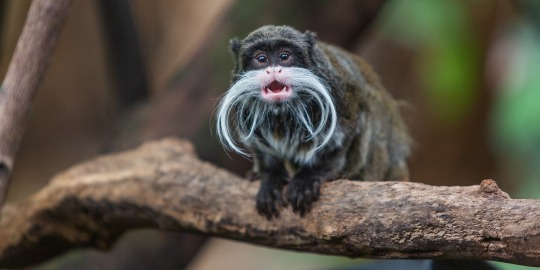
This tiny, tiny tamarin is found in the wet forests where Brazil and Peru border each other. They eat fruit, flowers, fungus, and tree sap- but they’re apparently too lazy to dig their own holes in trees, so they wait for a different species to do it for them. And, of course, they have those magnificent moustaches.
10 notes
·
View notes
Text
Primate tournament semifinals part 2
Japanese macaque (Macaca fuscata)

Beaten only by humans for the title of the furthest-north primate, this monkey lives in a huge range of climates on the islands of Japan, including snowy and mountainous regions. They are famous for their habit of spending time in hot springs to escape the cold. They are also rather intelligent, one group of macaques inventing the idea to wash their food before consumption. They eat a variety of foods, including leaves, fruits, bark, roots, insects, fish, soil, and fungus. Finally, the Japanese macaque is another species of monkey in which homosexuality has been documented; it has even been proposed that most female members of this species are bisexual!
Bornean orangutan (Pongo pygmaeus)

These large tree-dwelling apes are found only on the island of Borneo. They are highly sexually dimorphic, with dominant males growing large cheek flanges. They eat fruits, leaves, flowers, bark, honey, small animals like insects, spider webs, fungus, and soil. They build complex nests to sleep in, and have been observed using leafy makeshift ‘umbrellas’, sticks to obtain foods like ants, and leaves to hold spiny fruits.
#this tournament is almost over unfortunately#but I’ve been working on something else on the side that will come to fruition on May 8!#thank you all for enjoying the tournament#it has been a real treat getting to see your enthusiasm for all the wonderful primates of the world
24 notes
·
View notes
Text
Primate tournament semifinals: part 1
Verreaux’s sifaka (Propithecus verreauxi)

These lemurs are very specialised for living in trees, eating mostly leaves and being capable of leaping ten metres from tree to tree. They also live in a variety of wet or dry forest habitats. Sifakas are so specialised for climbing they can’t walk on all fours like a ring-tailed lemur, nor can they stride bipedally like humans; instead, they move on the ground using an odd bipedal bounding motion.
Bearded emperor tamarin (Saguinus imperator subgrisescens)

This tiny, tiny tamarin is found in the wet forests where Brazil and Peru border each other. They eat fruit, flowers, fungus, and tree sap- but they’re apparently too lazy to dig their own holes in trees, so they wait for a different species to do it for them. And, of course, they have those magnificent moustaches.
10 notes
·
View notes
Text
Primate tournament semifinals part 2
Japanese macaque (Macaca fuscata)

Beaten only by humans for the title of the furthest-north primate, this monkey lives in a huge range of climates on the islands of Japan, including snowy and mountainous regions. They are famous for their habit of spending time in hot springs to escape the cold. They are also rather intelligent, one group of macaques inventing the idea to wash their food before consumption. They eat a variety of foods, including leaves, fruits, bark, roots, insects, fish, soil, and fungus. Finally, the Japanese macaque is another species of monkey in which homosexuality has been documented; it has even been proposed that most female members of this species are bisexual!
Bornean orangutan (Pongo pygmaeus)

These large tree-dwelling apes are found only on the island of Borneo. They are highly sexually dimorphic, with dominant males growing large cheek flanges. They eat fruits, leaves, flowers, bark, honey, small animals like insects, spider webs, fungus, and soil. They build complex nests to sleep in, and have been observed using leafy makeshift ‘umbrellas’, sticks to obtain foods like ants, and leaves to hold spiny fruits.
24 notes
·
View notes
Text
Primate tournament semifinals: part 1
Verreaux’s sifaka (Propithecus verreauxi)

These lemurs are very specialised for living in trees, eating mostly leaves and being capable of leaping ten metres from tree to tree. They also live in a variety of wet or dry forest habitats. Sifakas are so specialised for climbing they can’t walk on all fours like a ring-tailed lemur, nor can they stride bipedally like humans; instead, they move on the ground using an odd bipedal bounding motion.
Bearded emperor tamarin (Saguinus imperator subgrisescens)

This tiny, tiny tamarin is found in the wet forests where Brazil and Peru border each other. They eat fruit, flowers, fungus, and tree sap- but they’re apparently too lazy to dig their own holes in trees, so they wait for a different species to do it for them. And, of course, they have those magnificent moustaches.
10 notes
·
View notes
Text
Round 4, part 4: apes
Bornean orangutan (Pongo pygmaeus)

These large tree-dwelling apes are found only on the island of Borneo. They are highly sexually dimorphic, with dominant males growing large cheek flanges. They eat fruits, leaves, flowers, bark, honey, small animals like insects, spider webs, fungus, and soil. They build complex nests to sleep in, and have been observed using leafy makeshift ‘umbrellas’, sticks to obtain foods like ants, and leaves to hold spiny fruits.
Western lowland gorilla (Gorilla gorilla gorilla)
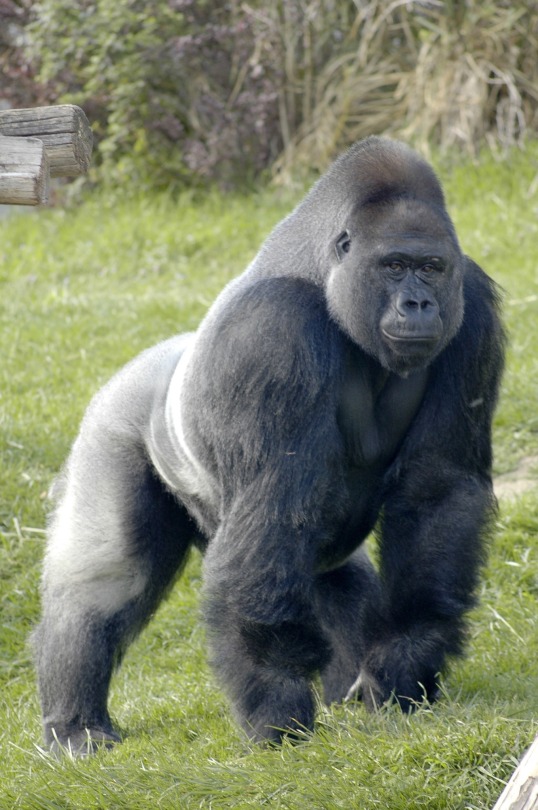
These huge, powerful apes are found in the lowland tropical forests of Western Africa. They are highly sexually dimorphic, and dominant males are often called silverbacks for their light grey backs. They eat leaves, fruits, roots, tree bark, and occasionally small animals. They are also known to use tools, and famously Koko the gorilla was apparently able to communicate using sign language, although the extent to which she understood has been questioned by many scientists. I chose to use this subspecies because their full scientific name (Gorilla gorilla gorilla) is funny to me.
16 notes
·
View notes
Text
Round 4, part 3: old world monkeys
Red-shanked douc (Pygathrix nemaeus)

This fabulous-looking species is found in tropical, sometimes mountainous forests of Southeast Asia. They eat mostly leaves, and have a multi-chambered stomach which allows them to ferment their food, like a ruminant!
Japanese macaque (Macaca fuscata)
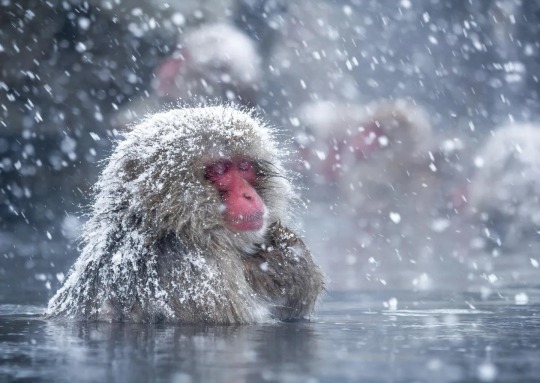
Beaten only by humans for the title of the furthest-north primate, this monkey lives in a huge range of climates on the islands of Japan, including snowy and mountainous regions. They are famous for their habit of spending time in hot springs to escape the cold. They are also rather intelligent, one group of macaques inventing the idea to wash their food before consumption. They eat a variety of foods, including leaves, fruits, bark, roots, insects, fish, soil, and fungus. Finally, the Japanese macaque is another species of monkey in which homosexuality has been documented; it has even been proposed that most female members of this species are bisexual!
20 notes
·
View notes
Text
Round 4, part 1: basal primates
Bengal slow loris (Nycticebus bengalensis)

Slow lorises are nocturnal inhabitants of Southeast Asian forests. They’re also the only venomous primates, and one of the only groups of venomous mammals. They produce certain chemicals in a gland near their armpit, and others in their saliva; when mixed, either by licking their armpit or wiping their gland juice on their teeth, the chemicals combine to produce a noxious toxin.
This species is the largest of the slow lorises. The chemicals produced from their armpit gland may not just be for defence, but also for communicating information with other lorises via scent. It eats small animals, mostly insects, as well as fruit and tree sap.
Verreaux’s sifaka (Propithecus verreauxi)

These lemurs are very specialised for living in trees, eating mostly leaves and being capable of leaping ten metres from tree to tree. They also live in a variety of wet or dry forest habitats. Sifakas are so specialised for climbing they can’t walk on all fours like a ring-tailed lemur, nor can they stride bipedally like humans; instead, they move on the ground using an odd bipedal bounding motion.
15 notes
·
View notes
Text
Round 4, part 2: new world monkeys
Bearded emperor tamarin (Saguinus imperator subgrisescens)
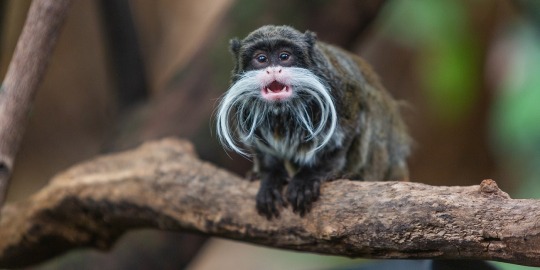
This tiny, tiny tamarin is found in the wet forests where Brazil and Peru border each other. They eat fruit, flowers, fungus, and tree sap- but they’re apparently too lazy to dig their own holes in trees, so they wait for a different species to do it for them. And, of course, they have those magnificent moustaches.
Yellow-tailed woolly monkey (Lagothrix flavicauda)

This woolly monkey is an incredibly rare and elusive species, despite its relatively large size. It lives in the high-altitude cloud forests of the Andes mountains in Peru. In the last 200 years, only a few sightings of the species have been brought to scientific attention, and it was believed to have been extinct for most of the 19th century. But while it is now known to be extant, habitat loss means that it may not be for much longer.
12 notes
·
View notes
Text
Round 4, part 1: basal primates
Bengal slow loris (Nycticebus bengalensis)

Slow lorises are nocturnal inhabitants of Southeast Asian forests. They’re also the only venomous primates, and one of the only groups of venomous mammals. They produce certain chemicals in a gland near their armpit, and others in their saliva; when mixed, either by licking their armpit or wiping their gland juice on their teeth, the chemicals combine to produce a noxious toxin.
This species is the largest of the slow lorises. The chemicals produced from their armpit gland may not just be for defence, but also for communicating information with other lorises via scent. It eats small animals, mostly insects, as well as fruit and tree sap.
Verreaux’s sifaka (Propithecus verreauxi)

These lemurs are very specialised for living in trees, eating mostly leaves and being capable of leaping ten metres from tree to tree. They also live in a variety of wet or dry forest habitats. Sifakas are so specialised for climbing they can’t walk on all fours like a ring-tailed lemur, nor can they stride bipedally like humans; instead, they move on the ground using an odd bipedal bounding motion.
15 notes
·
View notes
Text
Round 4, part 2: new world monkeys
Bearded emperor tamarin (Saguinus imperator subgrisescens)

This tiny, tiny tamarin is found in the wet forests where Brazil and Peru border each other. They eat fruit, flowers, fungus, and tree sap- but they’re apparently too lazy to dig their own holes in trees, so they wait for a different species to do it for them. And, of course, they have those magnificent moustaches.
Yellow-tailed woolly monkey (Lagothrix flavicauda)

This woolly monkey is an incredibly rare and elusive species, despite its relatively large size. It lives in the high-altitude cloud forests of the Andes mountains in Peru. In the last 200 years, only a few sightings of the species have been brought to scientific attention, and it was believed to have been extinct for most of the 19th century. But while it is now known to be extant, habitat loss means that it may not be for much longer.
12 notes
·
View notes
Text
Round 4, part 3: old world monkeys
Red-shanked douc (Pygathrix nemaeus)

This fabulous-looking species is found in tropical, sometimes mountainous forests of Southeast Asia. They eat mostly leaves, and have a multi-chambered stomach which allows them to ferment their food, like a ruminant!
Japanese macaque (Macaca fuscata)

Beaten only by humans for the title of the furthest-north primate, this monkey lives in a huge range of climates on the islands of Japan, including snowy and mountainous regions. They are famous for their habit of spending time in hot springs to escape the cold. They are also rather intelligent, one group of macaques inventing the idea to wash their food before consumption. They eat a variety of foods, including leaves, fruits, bark, roots, insects, fish, soil, and fungus. Finally, the Japanese macaque is another species of monkey in which homosexuality has been documented; it has even been proposed that most female members of this species are bisexual!
20 notes
·
View notes